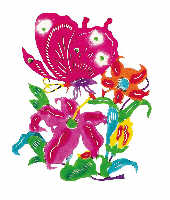There are some special papercuts of traditional designs. These are used as the patterns for embroidery on clothes, shoes, hats, pillows, bed curtains and door Curtains. The cutter first cuts the outline of the pattern, then sews it onto another piece of paper. The paper is then charred by a lamp or candle and the sewn pattern outline removed. Thus the original design is saved to provide the pattern for embroidery. In this way traditional patterns have been handed on from generation to generation.
 |
 |
Chinese papercuts are rich in content. The auspicious designs symbolize good luck and the avoidance of evil. The child, lotus and bottle gourd designs indicate a family with large number of children and grandchildren. Domestic birds, livestock, fruits, fish and worms are also familiar objects depicted by Chinese farmers. Papercuts made in different areas have different characteristics. The Shaanxi window papercuts are simple and bold. The Wei County papercuts from Hebei Province and the Guangling papercuts from Shanxi Province are applied with colors and portray many opera figures. The Nanjing papercuts of Jiangsu Province are simple, robust and skillful. The Yixing papercuts of Jiangxi Province are magnificent and neat The Nantong papercuts of Jiangsu Province are delicate and beautiful. The Foshan papercuts of Guangdong Province are colorful and decorative and utilize varied production skills. And the Gaomi papercuts of Shandong Province are delicate and fine.
Papercut works have been found in many Chinese relics, and the art form's history can be traced back about 1,500 years to the Northern Dynasties (386-581). Though they require very simple making skills, their contents are rich and reveal many local Chinese customs. Papercuts typically demonstrate the preferred aesthetics of shape and the artistic concepts behind Chinese folk handicrafts. An understanding and scrutiny of papercuts is a good beginning to get to know and appreciate the complexity of Chinese folk arts.
